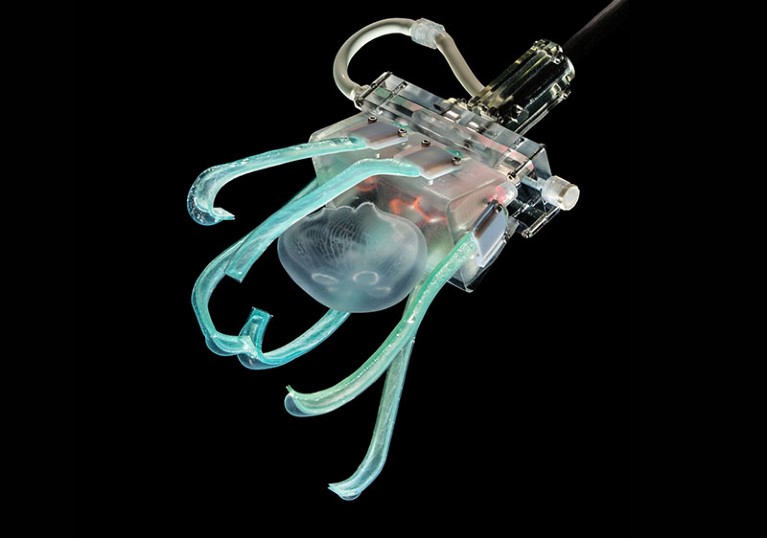
A robot arm with ultra-gentle fingers clasps a jellyfish.Credit: Anand Varma
It is well known that research in artificial intelligence (AI) and robotics is on a steep upward trajectory, but the latest numbers from the Nature Index put the growth rate beyond doubt. In just two years, the number of articles in the 82 high-quality natural-science journals tracked by the Nature Index linked to these topics has gone from fewer than 4,000 in 2019 to approaching 7,000 in 2021. Using the Nature Index metric of Share, which uses fractional counting of author affiliations, the data are even more dramatic. Both China and South Korea have increased their Share by more than 1,100% from 2015 to 2021, although the United States is still the clear leader overall.
Nature Index 2022 AI and robotics
Such growth, and the way it is representing an ever-increasing proportion of institutions’ Nature Index output, shows how this pervasive technology is crossing disciplinary boundaries as researchers seek ways to use its advantages. In this supplement, we take a closer look how AI and robotics are making advancement possible, from environmental science to the humanities, as well as having immediate real-world impact in areas such as clinical medicine. We also look at how interdisciplinary approaches are prompting researchers to rethink AI and robotics itself, particularly by drawing inspiration from the natural world.
But controversy lurks when dealing with emerging technologies, in part owing to concerns about the role being played by commercial organizations. Despite the huge influence wielded by tech firms, and their ability to attract top talent from academia, their footprint in the Index is still modest. It is bound to raise concerns about whether there is enough openness about the AI tools and techniques that are transforming society.
There are also continuing concerns about whether cutting-edge developments in AI and robotics are benefiting people from all walks of life; we speak to one researcher drawing attention to how rural communities risk being left out of AI advancements.

 Four ways that AI and robotics are helping to transform other research fields
Four ways that AI and robotics are helping to transform other research fields
 Growth in AI and robotics research accelerates
Growth in AI and robotics research accelerates
 Pandemic’s cancer backlogs receive treatment from AI innovation
Pandemic’s cancer backlogs receive treatment from AI innovation
 The rural areas missing out on AI opportunities
The rural areas missing out on AI opportunities
 Insects offer inspiration for robot advances
Insects offer inspiration for robot advances
 Is big tech draining AI talent from academia?
Is big tech draining AI talent from academia?




